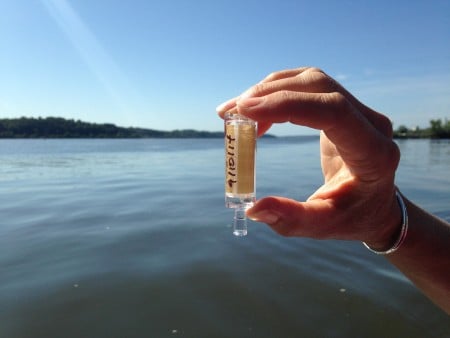Data to the Rescue: Stopping Water Pollution

A water sample for DNA analysis. Photo by Dan Shapley/Riverkeeper
View more images on our Flickr site
Riverkeeper was recently invited to make a presentation at the 2015 Mohawk Watershed Symposium, Inspiring People to Stop Water Pollution Through Community Science.
Riverkeeper has been sampling the Hudson River since 2008, and in tributarie and along the New York City waterfront, in partnership with a variety of individuals and community groups, since 2011 and 2012. As we sample, we follow a simple mantra suggested early on by our science partners, Dr. Greg O’Mullan and Dr. Andy Juhl: “Let the data do the talking.” Where the data show problems, solutions often follow. Here’s a look at some of the accomplishments that have resulted from gathering and publicizing data. It should be noted that in none of these cases were lawsuits filed or threatened; the Water Quality Program uses advocacy and communications as its main tools for effecting change.
Enforcement
- An illegal hookup of a sewer to a storm drain, which had resulted in contamination of Hallets Cove on the East River, was stopped after local advocates urged the New York City Department of Environmental Protection to investigate high bacterial counts.
- An illegal hookup to a storm sewer on the Catskill Creek was stopped, and the polluter fined, after data showed high bacterial counts.
- High dry-weather bacterial counts in the Hudson River at the Newburgh boat launch prompted the city to use dye testing to identify one or more properties that had sewer lines connected to storm drains.
Infrastructure Investment
- Riverkeeper’s data helped inform the decision to make “swimmable water” the goal of the $136 million Long Term Control Plan for Capital District combined sewer overflows (CSOs).
- Westchester County committed to a $9.9 million upgrade to a failing pumping station in Tarrytown, after Riverkeeper water quality data showed high bacterial counts in the Hudson River nearby.
- A sewer line will be extended to the hamlet of Leeds on the Catskill Creek, to replace failing septics there. Data showing water quality issues helped inform the Town Board’s decision.
- A $100,000 fix for a 50-year-old failing pump station on the Sparkill Creek was prioritized, in part because data showed the issue wasn’t just about dollars and cents, but environmental and public health.
- Data gathered by Riverkeeper and citizens groups are informing decisions about New York City’s CSO Long Term Control Plans for the Gowanus Canal, Bronx River and other waters.
Public Notification
- Riverkeeper argued for passage of the Sewage Pollution Right to Know Law in 2012. While implementation is incomplete, the law has already resulted in prioritization of raw sewage releases at the Department of Environmental Conservation, the public reporting of thousands of discharges, and the first-ever electronic public alerts.
- As part of its CSO Long Term Control Plan, the Capital District uses modeling to report publicly when its CSO outfalls are expected to discharge raw sewage. Kingston uses realtime monitoring to report publicly when sewage is being discharged through its CSO outfalls.
- The Village of New Paltz will post signs at village hall, on Web and at two public access points on the Wallkill River, to inform public of monitoring data suggesting risk from fecal contamination.
